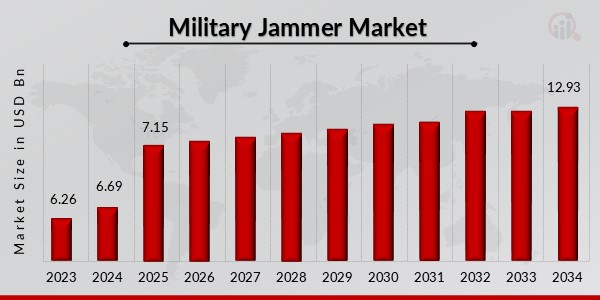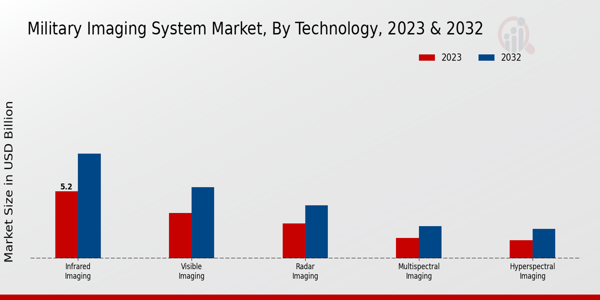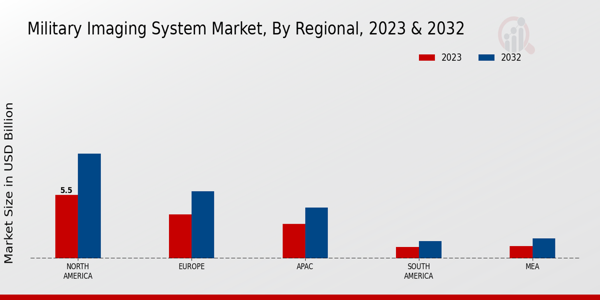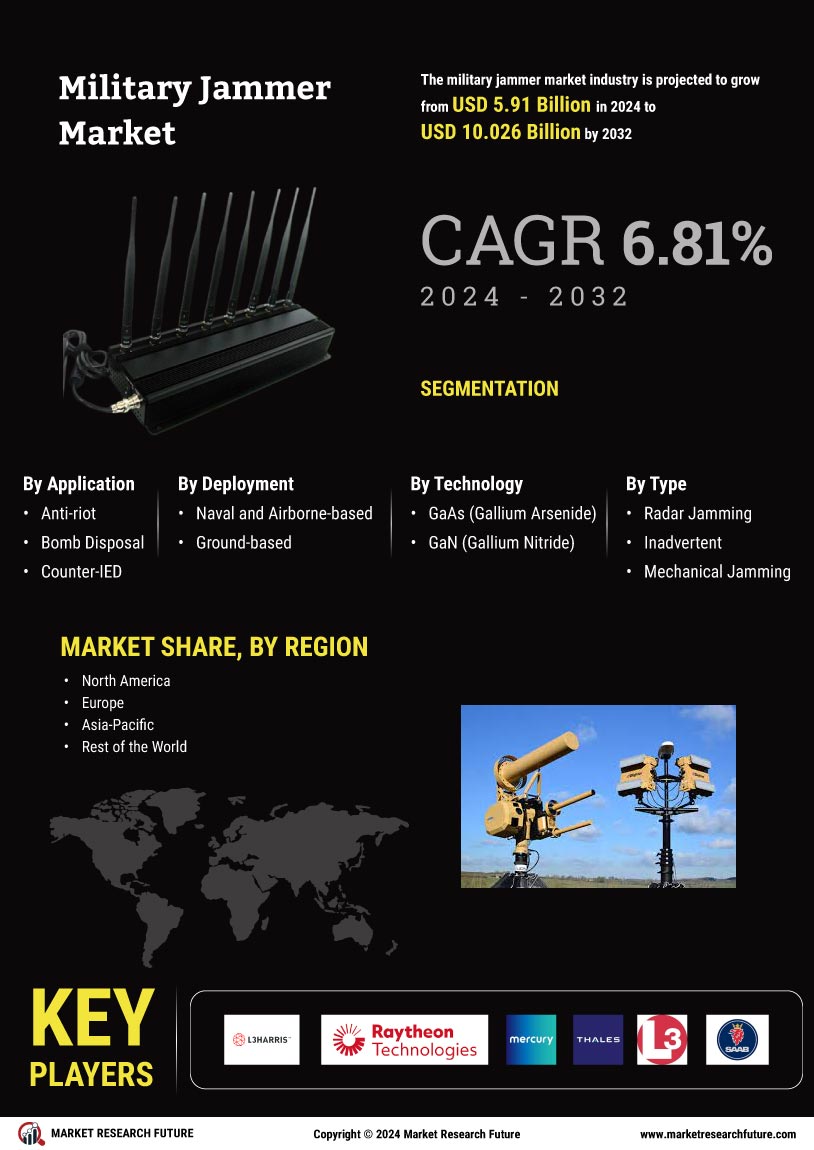Global Military Jammer Market Overview
Military Jammer Market Size was valued at USD 6.690 Billion in 2024. The military jammer market industry is projected to grow from USD 7.15 Billion in 2025 to USD 12.9310632463991 Billion by 2034, exhibiting a compound annual growth rate (CAGR) of 6.81% during the forecast period (2025 - 2034). Large capital investments from the governments of many established and emerging countries have been one of the key market drivers that have led to the expansion of the military jammer market. Additionally, certain favorable factors in the market are brought about by the requirement for an appropriate and effective defence system at military sites and borders.

Source Secondary Research, Primary Research, MRFR Database and Analyst Review
Key Military Jammer Market Trends Highlighted
The growing requirement for improved military communication security and the rise in international wars are driving the significant expansion of the military jammer market. To combat threats like cyberattacks and electronic warfare, governments are making significant investments in the development of new technology.
The need for effective jammer systems to block enemy signals and safeguard sensitive data is growing as military operations depend more on digital communication. Technological developments such as artificial intelligence and machine learning are also impacting the industry by making it possible for more advanced jamming solutions to react to threats in real time.
As countries realize they need better defence capabilities, market opportunities are growing. Innovative goods and solutions suited to military requirements will result from cooperation between government organizations and private businesses.
Additionally, new competitors may be able to gain market share by providing specialized jamming technologies when rising economies boost their defense budgets.
The growing trend towards cybersecurity is also prompting investment in jamming systems that can protect military networks from electronic interference. In recent times, the awareness of the importance of unmanned aerial vehicles (UAVs) in military operations has risen.
This trend is creating possibilities for jamming systems designed to counter drone threats. Moreover, with the shift towards network-centric warfare, there is a pressing need for solutions that can effectively manage and control electronic spectrum operations.
Militaries are prioritizing research and development to ensure they stay ahead of adversaries, which will support ongoing advancements in the jamming technology landscape. As these dynamics continue to evolve, the market is poised for sustained growth, driven by both technological innovation and the necessity for robust defense strategies.
Military Jammer Market Drivers
Growing Demand for Advanced Electronic Warfare Capabilities
The Military Jammer Market is experiencing a significant rise in demand for advanced electronic warfare capabilities.
The increasing complexity of contemporary warfare, coupled with the proliferation of sophisticated enemy communication and control systems, has led military organizations to seek enhanced jamming solutions. These solutions are vital for disrupting adversary communications, radar, and other electronic systems that can provide tactical advantages on the battlefield.
As nations invest in modernizing their defense strategies, the focus on developing and acquiring effective jamming systems becomes critical. Furthermore, advancements in technology have led to the development of more effective and efficient jammers, which are capable of operating across a broader spectrum of frequencies.
This not only enhances their capabilities but also ensures they can adapt to new threats as they emerge. Consequently, the growing emphasis on electronic warfare and the need for superiority in battlespace signal intelligence are key drivers propelling the Military Jammer Market's growth.
Militaries around the world recognize that the ability to deny or disrupt enemy communications and radars is essential to maintaining a strategic advantage. As such, the need for investment in the research and development of next generation jamming systems presents significant opportunities for market players, fostering innovation and expansion in the Military Jammer Market.
Increased Military Expenditure by Governments
The Military Jammer Market is being significantly driven by increased military expenditure from governments worldwide. As nations face the need to modernize their armed forces, budgets allocated for defense have seen a substantial uptick.
This surge in spending is mainly aimed at enhancing capabilities across various domains, including land, air, naval, and cyber operations. As a part of this modernization effort, military organizations are placing a higher priority on upgrading their electronic warfare technologies, leading to a higher demand for advanced military jammers.
Additionally, geopolitical tensions and conflicts across different regions have further pushed countries to bolster their military readiness to account for unpredictable threats. This increased focus on defense, specifically on capabilities like jamming technologies, is expected to have a positive impact on the overall growth prospects of the Military Jammer Market.
Rising Security Concerns and Cyber Threats
The rise in security concerns, alongside growing cyber threats, is emerging as a notable driver in the Military Jammer Market. Governments and military organizations are increasingly recognizing the vulnerabilities associated with modern warfare, where adversaries may employ cyber tactics to disrupt operations.
Jamming systems offer an effective line of defense against these threats by denying enemy usage of specific frequencies and controlling communications in contested environments.
This urgency to secure military networks and infrastructure against both traditional and novel threats underscores the necessity for advanced jamming solutions, propelling further investment in this area.
Military Jammer Market Segment Insights
Military Jammer Market Type Insights
The Military Jammer Market displayed a significant landscape segmented by type, reflecting various technologies employed in military operations. The segment comprises several key technologies, including Communication Jammers, Radar Jammers, Missile Jammers, and Drone Jammers, each valued differently based on their applications and importance in the defense ecosystem.
The Communication Jammer led the market with a valuation of 1.5 USD Billion in 2023 and is projected to rise to 2.5 USD Billion by 2032.
This sub-segment was significant as it ensured the disruption of enemy communication channels, enhancing operational security and tactical advantages.
Following closely was the Radar Jammer, valued at 1.2 USD Billion in 2023, which plays a vital role in stealth operations by obscuring the presence of military assets from enemy radar systems, predicting an increase to 2.0 USD Billion by 2032.
With military operations becoming increasingly reliant on technological advancements, the Missile Jammer, valued at 1.3 USD Billion in 2023, solidified its importance by countering missile threats, ensuring the protection of troops and assets, with expected growth to 2.3 USD Billion in 2032.
While the Drone Jammer represented a smaller segment, valued at 0.43 USD Billion in 2023 and forecasted to reach 0.7 USD Billion by 2032, its potential is rising due to the increasing risks posed by unmanned aerial vehicles.
Collectively, these insights into the Military Jammer Market segmentation highlighted the importance of each sub-type, underscoring how communication and radar jammers dominate the market, while missile and drone jammers carve out essential niches in modern warfare, reflecting the growing demand for sophisticated electronic warfare capabilities.
The Military Jammer Market statistics revealed a structured expansion marked by each type's unique contributions to military readiness and operational success. Market growth is fueled by the increasing complexities of warfare, evolving threats, and the persistent need for securing communication lines and protecting military forces, paving the way for numerous opportunities in the evolving defense industry landscape.
Source Primary Research, Secondary Research, MRFR Database and Analyst Review
Military Jammer Market Platform Insights
The Platform segment encompasses various operational domains, primarily Land, Airborne, and Naval. This diverse segmentation reflects the necessity for military jamming capabilities across different tactical environments, ensuring comprehensive electronic warfare. The Land category is significant as ground forces increasingly rely on jamming systems to counter threats from enemy communications and GPS-guided munitions.
The Airborne segment has also gained importance, as airborne systems provide a strategic advantage by disrupting enemy signals from a height, thereby enhancing mission success. Naval operations dominate with substantial demand as maritime forces adopt advanced jamming technologies to protect against radar and missile systems in a complex naval battleground.
With these platforms driving growth, the Military Jammer Market demonstrates strong potential, bolstered by increasing investments in defense technologies and rising geopolitical tensions across the globe.
The expected market growth further points towards an evolving landscape of electronic warfare and the need for effective jamming solutions across multiple platforms.
Military Jammer Market Application Insights
The Military Jammer Market showcases significant growth potential across its various applications, particularly in Electronic Warfare, Countermeasures, and Military Operations. As military forces increasingly rely on advanced technologies, the application segment is positioned to see major expansions, driven by the rising need for secure communication and disruption of enemy signals.
Electronic Warfare is pivotal for enhancing military capabilities, allowing forces to gain information superiority by neutralizing adversary communication systems.
Countermeasures play a crucial role in protecting military assets from electromagnetic threats, making them an essential part of modern warfare strategies. Military Operations benefit from jamming technologies as they provide tactical advantages in complex battle environments, ensuring seamless operations.
This growing demand highlights the importance and dynamic nature of the Military Jammer Market, emphasizing the need for strategic advancements across its application areas, reinforced by relevant Military Jammer Market statistics and data.
Military Jammer Market End Use Insights
The Military Jammer Market is witnessing substantial growth, fueled by its applications across various end-use sectors. The upward trend is largely driven by the essential role that jammers play in military operations, particularly in countering threats and ensuring communication security on the battlefield.
Among the end users, military applications hold a prominent position, as the need for effective electronic warfare capabilities drives the demand for advanced jamming systems.
Defense contractors are also significant contributors, providing innovative solutions tailored to meet the evolving needs of the armed forces. Additionally, government agencies utilize military jammers for various purposes, including law enforcement and national security, reinforcing the segment's importance in safeguarding critical infrastructures.
The Military Jammer Market data reveals a steady growth trajectory influenced by advancements in technology and increasing investments in defense sector capabilities, showcasing a robust landscape ripe with opportunities while also facing challenges around regulatory compliance and technological integration.
As the market progresses toward 2032, these factors will continue to shape the industry dynamics and consumer demands within the Military Jammer Market segmentation.
Military Jammer Market Regional Insights
The Military Jammer Market experienced notable growth across various regions, with North America leading the market, holding a significant valuation of 2.0 USD Billion in 2023 and projected to reach 3.4 USD Billion by 2032. This dominance was largely attributed to the advanced military systems and investments in defense technology within this region.
Europe followed with a valuation of 1.2 USD Billion in 2023, increasing to 2.0 USD Billion by 2032, driven by rising security concerns and upgrading existing defense infrastructure. The APAC region, valued at 0.9 USD Billion in 2023 and expected to climb to 1.5 USD Billion by 2032, witnessed growth due to increasing geopolitical tensions and modernization initiatives among countries.
Meanwhile, South America held a modest share with a valuation of 0.2 USD Billion in 2023, rising to 0.3 USD Billion by 2032, reflecting a gradual increase in defense spending. The MEA region presented a similar scenario, valued at 0.13 USD Billion in 2023 and anticipated to reach 0.3 USD Billion by 2032, as nations invest in combating terrorism and safeguarding national integrity.
These statistics indicated a diverse landscape of growth opportunities, highlighting the importance of regional dynamics in the Military Jammer Market.
Source Primary Research, Secondary Research, MRFR Database and Analyst Review
Military Jammer Market Key Players and Competitive Insights
The Military Jammer Market is characterized by intense competition, driven by the increasing demand for advanced technologies to counteract enemy communications and electronic warfare tactics. This market is influenced by various factors, including geopolitical tensions, military modernization programs, and the need for enhanced operational capabilities among armed forces worldwide.
As countries invest heavily in their defense systems, the market for military jammers has experienced substantial growth, leading to the emergence of numerous players that compete on the foundation of technological innovation, strategic partnerships, and comprehensive service offerings.
Players in this sector are continuously evolving their product portfolios and exploring collaborations with defense contractors to stay ahead in a fast-paced environment increasingly dictated by emerging threats and the need for robust electronic defenses.
General Dynamics holds a prominent position within the Military Jammer Market, recognized for its strengths in the design, development, and production of high-performance electronic warfare systems. The company's extensive experience and technological prowess allow it to offer a wide range of jamming solutions tailored to meet the varied requirements of military operations.
With a commitment to innovation, General Dynamics focuses on integrating cutting-edge technologies into its products, thereby enhancing their effectiveness in countering sophisticated threats. The company also benefits from a strong reputation within the defense sector, supported by a broad customer base that spans multiple countries.
Its ability to deliver reliable and adaptable solutions positions General Dynamics favorably against competitors, enabling the company to maintain a significant market presence.
Rohde and Schwarz have carved out a niche within the Military Jammer Market by leveraging their deep expertise in radio communications and electronic warfare. Known for its comprehensive range of jamming systems, the company specializes in providing solutions that cater specifically to the needs of armed forces engaged in a variety of operations.
Rohde and Schwarz emphasize the development of versatile and scalable jamming technology that can effectively address the evolving spectrum of threats faced by military personnel. The company's strong focus on research and development allows it to introduce advanced products that set the standard in the market, ensuring their effectiveness in real-world scenarios.
Additionally, through strategic collaborations and partnerships with other defense entities, Rohde and Schwarz continue to enhance its offerings while broadening its reach in the increasingly competitive landscape of military jammers.
Key Companies in the Military Jammer Market Include
- General Dynamics
- Rohde and Schwarz
- Thales Group
- BAE Systems
- Northrop Grumman
- Honeywell
- Rockwell Collins
- Harris Corporation
- SAAB
- Leonardo
- Kratos Defense and Security Solutions
- L3Harris Technologies
- Lockheed Martin
- Raytheon
- Elbit Systems
Military Jammer Market Developments
The Military Jammer Market has witnessed significant developments recently, particularly with companies like General Dynamics, Northrop Grumman, and Thales Group enhancing their technological capabilities. Increased military spending globally has pushed demand for sophisticated jamming systems, especially amid rising geopolitical tensions.
Notable advancements in electronic warfare technologies from BAE Systems and L3Harris Technologies further elevate competitive dynamics in the sector. Market valuation for these companies has seen substantial growth, reflecting increased defense budgets and a shift toward modernization.
Additionally, there have been strategic acquisitions within the sector; for instance, Raytheon has emphasized the importance of acquiring innovative jamming technology to bolster its existing capabilities, while Elbit Systems has pursued expansion in electronic warfare solutions.
Companies like Rockwell Collins and Harris Corporation have also focused on integrating advanced technologies to secure higher market shares. These developments foster a robust environment for collaboration and competition, ultimately driving advancements in military jamming capabilities across the globe.
Military Jammer Market Segmentation Insights
Military Jammer Market Type Outlook
- Communication Jammer
- Radar Jammer
- Missile Jammer
- Drone Jammer
Military Jammer Market Platform Outlook
Military Jammer Market Application Outlook
- Electronic Warfare
- Countermeasures
- Military Operations
Military Jammer Market End Use Outlook
- Military
- Defense Contractors
- Government Agencies
Military Jammer Market Regional Outlook
- North America
- Europe
- South America
- Asia Pacific
- Middle East and Africa
Military Jammer Market Report Scope
Military Jammer Report Scope
| Report Attribute/Metric |
Details |
| Market Size 2024 |
USD 6.69010264211321 Billion |
| Market Size 2025 |
USD 7.15 Billion |
| Market Size 2032 |
USD 12.93 Billion |
| Compound Annual Growth Rate (CAGR) |
6.81% (2025-2034) |
| Base Year |
2023 |
| Market Forecast Period |
2025-2034 |
| Historical Data |
2018- 2021 |
| Market Forecast Units |
Value (USD Billion) |
| Report Coverage |
Revenue Forecast, Market Competitive Landscape, Growth Factors, and Trends |
| Segments Covered |
Application, Deployment, Technology, Type, and Region |
| Geographies Covered |
North America, Europe, Asia Pacific, and the Rest of the World |
| Countries Covered |
The US, Canada, German, France, UK, Italy, Spain, China, Japan, India, Australia, South Korea, and Brazil |
| Key Companies Profiled |
L3Harris Technologies Inc, Raytheon Company (U.S.), Mercury Systems Inc (U.S.), Thales Group (France), L-3 Technologies Inc (U.S.), Saab AB (Sweden), Northrop Grumman (U.S.), Israel Aerospace Industries Ltd (Israel), Lockheed Martin Corporation (U.S.) and Ultra Electronics Inc (U.K.) |
| Key Market Opportunities |
The need for a suitable and effective defence system at military sites and borders has some favorable effects on the market |
| Key Market Dynamics |
One of the main factors driving the growth of the military jammer market has been the substantial capital investments made by the governments of several developed and developing nations. |
Military Jammer Market Highlights:
Frequently Asked Questions (FAQ) :
The military jammer market size was valued at USD 6.26 Billion in 2023.
The market is projected to grow at a CAGR of 6.81% during the forecast period, 2025-2034.
North America is projected to dominate the Military Jammer Market with a value of 3.4 USD Billion by 2032.
The Communication Jammer segment is expected to be valued at around 2.5 USD Billion by 2032.
The Radar Jammer segment is projected to reach approximately 2.0 USD Billion by 2032.
Key players include General Dynamics, Thales Group, BAE Systems, Northrop Grumman, and Lockheed Martin.
The Drone Jammer segment is anticipated to grow to around 0.7 USD Billion by 2032.
The South American region is expected to reach a market size of approximately 0.3 USD Billion by 2032.
The Missile Jammer segment is expected to be valued at about 2.3 USD Billion by 2032.
Key applications include Communication Jamming, Radar Jamming, Missile Neutralization, and Drone Interference.

















